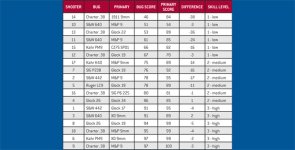Was up at the range yesterday with my carry gun. Here's a link to what the afternoon looked like (including target pictures):
Practice Time. Short answer to your question is that you can achieve excellent accuracy with a carry gun --
as long as you practice, and as long as you practice the right things.
Back when I was editing CCM, Karl Rehn wrote an excellent article titled, "
Is a Pocket Gun Enough?" In it, he discussed many of the common experiences people have with little guns and some of the concerns people express about them (caliber, accuracy, capacity, shootability). It's worth reading in its entirety, but one of the more fascinating things he did was that he ran a bunch of people through the same shooting test. Each person took the test twice: once with a full-size gun, and once with a pocket pistol.
He tested three groups of people:
- new or inexperienced shooters
- intermediate shooters who had taken classes
- highly skilled shooters
The higher the score the person shot on the test, the better they did.
What Rehn found was that shooters who were not highly skilled -- this would include new shooters, inexperienced shooters, and shooters who had taken no classes
other than the basic carry permit class -- gave up a LOT of skill when they moved to smaller guns. He also found that good shooters could move down to the small guns with very little, or no, loss of skill.
Here's the data:
Note that the trained shooters did
twice as well on the skills test as the untrained ones. It wasn't a minor difference.
Bottom line is, learn to be a good shooter. This includes taking professional training classes that help you build your gunhandling skills to the point of automaticity. Then you can choose the most convenient gun to carry without giving up anything on the achievement side of the bargain.
pax



